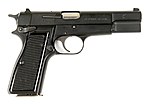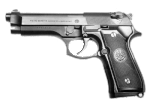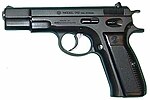Armed Forces of Honduras
| Armed Forces of Honduras | |
|---|---|
| Fuerzas Armadas de Honduras (Spanish) | |
 Coat of arms of the Honduran Armed Forces | |
| Founded | 1825 |
| Service branches | Honduran Army Honduran Air Force Honduran Navy |
| Website | Official website |
| Leadership | |
| Commander-in-Chief | Xiomara Castro |
| Minister of Defence | Rixi Moncada |
| Chairman of the Joint Chiefs of Staff | GEN Roosevelt Hernández Aguilar |
| Personnel | |
| Military age | 18 for voluntary 2–3-year service |
| Available for military service | 1,868,940[1] males, age 16–49, 1,825,770 (2008 est.) females, age 16–49 |
| Fit for military service | 1,397,938 males, age 16–49, 1,402,398 (2009 est.) females, age 16–49 |
| Reaching military age annually | 92,638 males, 88,993 (2009 est.) females |
| Active personnel | 52,225[2] |
| Expenditure | |
| Budget | $405,000,000[3] |
| Percent of GDP | 1.1% as of 2012[3] |
| Industry | |
| Foreign suppliers | |
| Related articles | |
| Ranks | Military ranks of Honduras |
The Armed Forces of Honduras (Spanish: Fuerzas Armadas de Honduras), consists of the Honduran Army, Honduran Navy and Honduran Air Force.
History
[edit]Pre-1979
[edit]The Armed Forces of Honduras were created through article 44, subsection 4 of the First Constitution of the Legislative Chamber in 1825, with the First Supreme Head of State being the Attorney Dionisio de Herrera, for which, they ordered the effective birth of the Honduran army in dated December 11, 1825 and for its greater mobility, it was divided into battalions with the name of each of the seven departments Comayagua the capital, Tegucigalpa, Choluteca, Olancho, Yoro, Gracias and Santa Bárbara that were in charge of strategically and tactically covering order and defense of the state, under French military doctrine. In 1831 the Military School was created with a seat at the San Francisco Barracks, and Colonel Narciso Benítez of Colombian origin was appointed director; From this school graduated: Francisco Morazán, José Antonio Márquez, Diego Vigil, Liberato Moncada, Joaquín Rivera and José Santos Guardiola who were presidents of Honduras, among others.
The first weaponry used was flintlock and gunpowder, the product of mixing sulfur, saltpeter, and coal in relative quantities: the Remington single-load rifle was one of the first bullet rifles that were introduced into the country during the government of General José María Medina. .
The second stage of the Armed Forces is between the years 1842 and 1876 when the collective uniform emerged in the mid-1840s when the troops of General José Santos Guardiola faced those of General Nicolás Ángulo, in 1845 in the " Combate del Obrajuelo ", in San Miguel, El Salvador. In 1865 the first attempt was made to organize a Naval Force with its respective regulations; however, the cost of this service made it unsustainable; However, there were several attempts to reactivate the idea and one of them was carried out by Doctor Policarpo Bonilla, who ordered the construction of the Tatumbla steamship in the Kiel shipyard, Germany on November 22, 1895, and then in 1896 respectively, General Manuel Bonilla had the 'Hornet built. While he administered Honduras, the Doctor and General Don Tiburcio Carias Andino also ordered the construction of the steamers Búfalo and El Tigre. On January 1, 1881, the first Military Code of the Honduran army was issued, a legal instrument to govern its own organization. During the twentieth century, Honduran military leaders frequently became presidents, either through elections or by coups d'état. General Tiburcio Carías Andino was elected in 1932, he later on called a constituent assembly that allowed him to be reelected, and his rule became more authoritarian until an election in 1948.
During the following decades, the military of Honduras carried out several coups d'état, starting in October 1955. General Oswaldo López Arellano carried out the next coup in October 1963 and a second in December 1972, followed by coups in 1975 by Juan Alberto Melgar Castro and in 1978 by Policarpo Paz García.
1980s
[edit]Events during the 1980s in El Salvador and Nicaragua led Honduras – with US assistance – to expand its armed forces considerably, laying particular emphasis on its air force, which came to include a squadron of US-provided F-5s.
The military unit Battalion 316 carried out political assassinations and the torture of suspected political opponents of the government during this same period. Battalion members received training and support from the United States Central Intelligence Agency, in Honduras, at U.S. military bases[4] and in Chile during the presidency of the dictator Augusto Pinochet.[5] Amnesty International estimated that at least 184 people "disappeared" from 1980 to 1992 in Honduras, most likely due to actions of the Honduran military.[6]
1990s
[edit]The resolution of the civil wars in El Salvador and Nicaragua, and across-the-board budget cuts made in all ministries, has brought reduced funding for the Honduran Armed Forces. The abolition of the draft has created staffing gaps in the now all-volunteer armed forces. The military is now far below its authorized strength, and further reductions are expected. In January 1999, the Constitution was amended to abolish the position of military Commander-in-Chief of the Armed Forces, thus codifying civilian authority over the Military.
2000s
[edit]Since 2002, soldiers have been involved in crime prevention and law enforcement, patrolling the streets of the major cities alongside the national police.
2009
[edit]On 28 June 2009, in the context of a constitutional crisis, the Military, acting on orders of the Supreme Court of Justice, arrested the President Manuel Zelaya, after which they forcibly removed elected President Zelaya from Honduras. See the article 2009 Honduran constitutional crisis regarding claims regarding legitimacy and illegitimacy of the event, and events preceding and following the removal of Zelaya from Honduras.
The military's chief lawyer, Colonel Herberth Bayardo Inestroza Membreño, made public statements regarding the removal of Zelaya. On June 30, he showed a detention order, apparently signed June 26 by a Supreme Court judge, which ordered the armed forces to detain the president.[7] Colonel Inestroza later stated that deporting Zelaya did not comply with the court order: "In the moment that we took him out of the country, in the way that he was taken out, there is a crime. Because of the circumstances of the moment this crime occurred, there is going to be a justification and cause for acquittal that will protect us."[8] He said the decision was taken by the military leadership "in order to avoid bloodshed".[9]
Following the 2009 ouster of the president, the Honduran military together with other government security forces were allegedly responsible for thousands of allegedly arbitrary detentions[10] and for several forced disappearances and extrajudicial executions of opponents to the de facto government, including members of the Democratic Unification Party. However, evidence about these actions has yet to be provided and there has been some questioning in local media about the actual perpetrators, suggesting that they could actually be related to disputes within the leftists organizations themselves.[11][12][13][14][15][16]
Army
[edit]This section needs expansion with: How large is the army, how is it structured, where are army bases located.. You can help by adding to it. (July 2015) |
The Honduran Army (Spanish: Ejército de Honduras, lit. 'Army of Honduras') is the land service branch of the Armed Forces of Honduras.
- 101st Brigade in Choluteca
- 105th Brigade in San Pedro Sula
- 110th Brigade in Danli
- 115th Brigade in Juticalpa
- 120th Brigade in Santa Rosa de Copan
Air Force
[edit]The FAH operates from four air bases located at:
- Hernan Acosta Mejia Air Base at Tegucigalpa
- Soto Cano Air Base at Comayagua,[17]
- Armando Escalon Espinal Air Base at La Lima, Cortés
- Hector Caraccioli Moncada at La Ceiba.
With the exception of Soto Cano Air Base, all other air bases operate as dual civil and military aviation facilities.
Additionally, three air stations are located at:
- Catacamas
- Alto Aguán (bomb range)
- Puerto Lempira airstrips serve as forward operations locations-FOL.
Also a radar station operates at:
- La Mole peak.
Navy
[edit]The Navy is a small force dealing with coastal and riverine security.
The Navy has 71 patrol boats, interceptors and landing craft units.
| Class | Origin | Type | Versions | In service | Fleet |
|---|---|---|---|---|---|
| ISRAEL SHIPYARDS Sa'ar 62-class offshore patrol vessel 62.0 meters / 204 feet |
Ocean patrol vessel | OPV-62M | 1 | FNH-2021 General Trinidad Cabañas Delivered by Israel Shipyard and arrived in country December 2019 | |
| Damen Stan Patrol Boat 42.8 meters / 140 feet |
Coastal patrol vessel | 4207 | 2 | FNH-1401 Lempira FNH-1402 General Francisco Morazán | |
| LANTANA BOATYARD Guardian Patrol Boats 32.3 meters / 107 feet |
Coastal patrol craft | 3 | FNH-1071 Tegucigalpa[18] FNH-1072 Copán FNH-1073 unknown name | ||
| SWIFTSHIPS Patrol Boats 32.0 meters / 105 feet |
Coastal patrol craft | 3 | FNH-1051 Guaymuras FNH-1052 Honduras FNH-1053 Hibueras | ||
| IAI Dabur Type Patrol Boat 26.0 meters / 85 feet |
Coastal patrol craft | 1 | FNH-8501 Chamelecón | ||
| SWIFTSHIPS Patrol Boats 20.0 meters / 65 feet |
Coastal patrol craft | 5 | FNH 6501 Nacaome FNH 6502 Goascorán FNH 6503 Patuca FNH 6504 Ulúa FNH 6505 Choluteca | ||
| BOSTON WHALER Interceptors BW370 11.4 meters / 38 feet |
Interceptor boat | Guardian class | 10 | N/A | |
| DAMEN Interceptors 1102 UHS 11.0 meters / 36 feet |
Interceptor boat | 1102 UHS | 6 | FNH-3601 to FNH-3606 | |
| SAFE BOATS 35MMI Multi Misión Interceptor 10.7 meters / 35 feet |
Interceptor boat | 35 MMI | 2[19] | FNH-3501 FNH-3502 | |
| EDUARDOÑO Patrullero 320 10.0 meters / 32 feet |
Interceptor boat | 25 | FNH-3201 to FNH-3225 | ||
| NAPCO Piraña Patrol Boats 4.0 meters / 13 feet |
Riverine ops boat | Piraña class | 8 | ||
| LANTANA BOATYARD Landing Craft Unit 45.5 meters / 149 feet |
Coastal transport | 1 | FNH-1491 Punta Caxinas | ||
| COTECMAR BAL-C Short Range Logistic Support Ship 49.0 meters / 161 feet |
Short Range Logistic Support Ship | BAL-C | 1 | FNH-1611 Gracias a Dios[20][21][22] | |
| SWIFTSHIPS LCM-8 Landing Craft Unit 22.9 meters / 75 feet |
Landing craft | 3 | FNH-7301 Warunta FNH-7302 Rio Coco FNH-7303 unknown name |
The Honduran navy has 4 naval bases:
- Base Naval Puerto Cortés – main repair and logistics base on the Caribbean Sea
- Base Naval Puerto Castilla – main operating base of patrol boats on the Caribbean Sea
- Base Naval Amapala – main operating base of coastal patrol craft on the north end of the island and only base on the Pacific Ocean side of Honduras
- Base Naval Caratasca – new base to deal with drug trafficking
Additionally, the Honduran navy has the following unit and schools:
- 1st. Marine Infantry Battalion – only marine unit located at La Ceiba
- Honduras Naval Academy – Trains officers for the Honduras Navy at La Ceiba
- Naval Training Center – NCO and Sailor training facility
Military-civilian relations and leadership
[edit]According to a statement in July 2009 by a legal counsel of the Honduras military, Colonel Herberth Bayardo Inestroza, part of the elite Honduran Military generals were opposed to President Manuel Zelaya, whom the Military had removed from Honduras via a military Coup d'état, because of his left-wing politics. Inestroza stated, "It would be difficult for us [the military], with our training, to have a relationship with a leftist government. That's impossible."[8]
The current Head of the Armed Forces is Carlos Antonio Cuéllar, graduate of the General Francisco Morazan Military Academy and the School of the Americas. In January 2011, the General Rene Arnoldo Osorio Canales, former Head of the Presidential Honor Guard, was appointed Commander.
As of 2012 the Honduran Military has the highest military expenditures of all Central America. They have 52,225 troops in their Army, they have 16,500 troops in their Air Force, and 5,300 troops in their Navy.[citation needed]
Equipment
[edit]Small arms
[edit]Anti-tank weapons
[edit]| Name | Image | Type | Origin | Caliber | Notes | |
|---|---|---|---|---|---|---|
| M40A1[32] | 
|
Recoilless rifle | 105mm | 50 in service. | ||
| Carl Gustav[33] | 
|
Recoilless rifle | 84mm |
Tanks
[edit]| Name | Image | Type | Origin | Quantity | Status | Notes |
|---|---|---|---|---|---|---|
| FV101 Scorpion | 
|
Light tank | 19 | |||
| FV107 Scimitar | 
|
Light tank | 3 |
Reconnaissance
[edit]| Name | Image | Type | Origin | Quantity | Status | Notes |
|---|---|---|---|---|---|---|
| RBY Mk 1 | 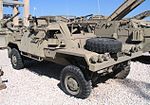
|
Reconnaissance vehicle | 8[34] | |||
| Alvis Saladin | 
|
Armored car | 40[35] |
Armored personnel carriers
[edit]| Name | Image | Type | Origin | Quantity | Status | Notes |
|---|---|---|---|---|---|---|
| FV105 Sultan | 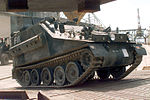
|
Armored personnel carrier | 1 |
Utility vehicles
[edit]| Name | Image | Type | Origin | Quantity | Status | Notes |
|---|---|---|---|---|---|---|
| Humvee | 
|
Light utility vehicle | 30 | |||
| M151[36] | 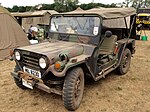
|
Utility vehicle | Unknown | |||
| KM420 | 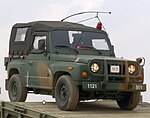
|
Utility vehicle | Unknown | |||
| Trucks | ||||||
| KM250 | 
|
Utility truck | Unknown | South Korean derivative of M35 | ||
| KM450 | 
|
Utility truck | Unknown | South Korean derivative of M715 | ||
| Tatra Force | 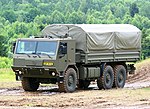
|
Utility truck | Unknown | |||
| M35[36] | 
|
Utility truck | Unknown | |||
| M54[36] | 
|
Utility truck | Unknown | |||
| Ashok Leyland Stallion[37] | 
|
Utility truck | 110 | |||
| Ashok Leyland Topchi[37] | Utility truck | 28 | ||||
Artillery
[edit]| Name | Image | Type | Origin | Quantity | Status | Notes |
|---|---|---|---|---|---|---|
| Mortars | ||||||
| M1[38] | 
|
Mortar | 200 | |||
| M29[38] | 
|
Mortar | 200 | |||
| Soltam M-65[39] | 
|
Mortar | 30 | |||
| Soltam M-66[39] | 
|
Mortar | 30 | |||
| Field artillery | ||||||
| M198[40] | 
|
Howitzer | 12 | |||
| M101 | 
|
Howitzer | 20 | |||
Air defence systems
[edit]| Name | Image | Type | Origin | Quantity | Status | Notes |
|---|---|---|---|---|---|---|
| M167 VADS | 
|
Rotary cannon | 30 |
See also
[edit]References
[edit]- ^ "CIA World Factbook". 8 September 2023.
- ^ "NationMaster.com".
- ^ a b "Stockholm International Peace Research Institute (SIPRI)". Archived from the original on 2015-01-04.
- ^ Cohn, Gary; Ginger Thompson (1995-06-11). "When a wave of torture and murder staggered a small U.S. ally, truth was a casualty". The Baltimore Sun. Archived from the original on 2011-05-22. Retrieved 2009-07-27.
- ^ Equipo Nizkor, LA APARICION DE OSAMENTAS EN UNA ANTIGUA BASE MILITAR DE LA CIA EN HONDURAS REABRE LA PARTICIPACION ARGENTINO-NORTEAMERICANA EN ESE PAIS., Margen (in Spanish)
- ^ "Honduras: Still waiting for justice". Amnesty International. 1998. Retrieved 2009-07-27.
- ^ Lacy, Marc (July 1, 2009). "Leader's Ouster Not a Coup, Says the Honduran Military". The New York Times. Retrieved July 3, 2009.
- ^ a b English summary of interview with the legal counsel of the Honduras armed forces, Colonel Herberth Bayardo Inestroza, Robles, Frances (2009-07-03). "Top Honduran military lawyer: We broke the law". Miami Herald. Archived from the original on 2009-09-06. Retrieved 2009-09-06.; original Dada, Carlos; José Luis Sanz (2009-07-02). "Cometimos un delito al sacar a Zelaya, pero había que hacerlo" (in Spanish). El Faro.net, El Salvador. Archived from the original on 2009-09-06. Retrieved 2009-09-06.
- ^ "Ejército de Honduras reconoció que cometió un delito al sacar a Zelaya". www.cooperativa.cl (in Spanish). Compañía Chilena de Comunicaciones S.A. Retrieved 2009-07-05.
- ^ "Preliminary Observations on the IACHR Visit to Honduras". Inter-American Court of Human Rights. 2009-08-21. Archived from the original on 2009-08-30. Retrieved 2009-08-26.
- ^ "Informe Preliminar Violaciones A Derechos Humanos En El Marco Del Golpe De Estado En Honduras". Comité de Familiares de Detenidos Desaparecidos en Honduras. 2009-07-15. Archived from the original on 2009-10-29. Retrieved 2009-07-30.
- ^ "International Observation Mission for the Human Rights Situation in Honduras Preliminary Report – Confirmed systematic human rights violations in Honduras since the coup d'etat". Upside Down World. 2009-08-06. Archived from the original on 2009-08-09. Retrieved 2009-08-09.
- ^ Pérez, Luis Guillermo; et al. (2009-08-06). "Gobierno de facto viola derechos humanos" (in Spanish). Agencia Latinoamerica de Información. Archived from the original on 2009-12-03. Retrieved 2009-08-26.
- ^ "International Mission denounces the brutal repression of pacific demonstrations". Agencia Latinoamerica de Información. 2009-07-30. Archived from the original on 2011-07-24. Retrieved 2009-08-02.
- ^ Quixote Center Emergency Delegation of Solidarity, Accompaniment and Witness (2009-08-07). "Letter to Honduran Attorney General Rubi". Quixote Center. Archived from the original on 2010-11-27. Retrieved 2009-08-09.
- ^ Human Rights Watch (2009-08-25). "Honduras: Rights Report Shows Need for Increased International Pressure". Human Rights Watch. Archived from the original on 2009-08-28. Retrieved 2009-08-28.
- ^ "Academia Militar de Aviación". Archived from the original on 2009-04-18.
- ^ "FNH 1071 Tegucigalpa UNITAS 2016". www.infodefensa.com.
- ^ "La Fuerza Naval de Honduras le compró a Cotecmar dos botes interceptores multimisión MMI 35 - Webinfomil". 19 October 2018.
- ^ "Cotecmar entregó a la Fuerza Naval de Honduras el buque logístico FNH 'Gracias a Dios'". www.webinfomil.com. 29 September 2017.
- ^ "Honduras firma contrato con COTECMAR para la construcción de buque naval". COTECMAR. Archived from the original on 2017-02-02. Retrieved 2017-01-28.
- ^ "Colombia, Honduras sign contract for COTECMAR vessel". IHS Jane's 360.
- ^ a b c d e f g h i j k Jones, Richard D. Jane's Infantry Weapons 2009/2010. Jane's Information Group; 35th edition (January 27, 2009). ISBN 978-0-7106-2869-5.
- ^ a b "Police Small Arms Arsenals in the Northern Central American Triangle". Small Arms Defense Journal. Vol. 7, no. 5. 4 December 2015.
- ^ Jones, Richard D.; Ness, Leland S., eds. (2009). Jane's Infantry Weapons 2009/2010 (35th ed.). Coulsdon: Jane's Information Group. p. 514. ISBN 978-0-7106-2869-5.
- ^ "¡Así Vamos!" (PDF). Indumil (in Spanish).
- ^ "Equiparán más unidades con MTAR 21". elheraldo.hn. Archived from the original on 2012-03-31. Retrieved 2012-04-17.
- ^ "Equiparán más unidades con MTAR 21". elheraldo.hn. Archived from the original on 2012-03-31. Retrieved 2012-04-17.
- ^ Alvaro Diaz. "Las Fuerzas Armadas de Honduras comenzarán el 2014 con nueva cúpula militar. El país busca en Israel asistencia técnica para repotenciar los F-5". Defensa.com. Archived from the original on 11 November 2014. Retrieved 11 November 2014.
- ^ Gander, Terry J.; Hogg, Ian V. Jane's Infantry Weapons 1995/1996. Jane's Information Group; 21 edition (May 1995). ISBN 978-0-7106-1241-0.
- ^ Jones, Richard; Ness, Leland S., eds. (2009). Jane's Infantry Weapons 2009–2010. Jane's Information Group. pp. 893–901. ISBN 978-0710628695.
- ^ Jane's World Armies 2008. Jane's Information Group. p. 318.
- ^ "country-data.com > Honduras > Appendix".
- ^ "Ramta RAM". Archived from the original on 2019-04-12.
- ^ International Institute for Strategic Studies (IISS) (2016). The Military Balance 2016. London: IISS. pp. 257–471. ISBN 978-1857438352.
- ^ a b c "Annex C Appendix II". US Army Technical Manual of Foreign Military Sales: Battlefield Damage Assessment and Repair (PDF). Washington, D.C. 18 December 1987. p. 262. TM 9-2320-356-BD. Archived (PDF) from the original on 4 September 2012. Retrieved 15 June 2013.
{{cite book}}: CS1 maint: location missing publisher (link) - ^ a b "A$10.5 million order for Ashok Leyland from Honduras". Machinist.in. 16 January 2009. Archived from the original on 18 January 2009. Retrieved 5 July 2009.
- ^ a b Jane's Infantry Weapons 2007–08. Jane's Information Group. p. 876.
- ^ a b "SIPRI arms transfer database". Stockholm International Peace Research Institute. 3 April 2014. Archived from the original on 14 April 2010. Retrieved 3 April 2014.
- ^ "Rock Island Arsenal M198 Towed 155mm Heavy Howitzer - United States". www.militaryfactory.com. Archived from the original on 2018-11-12. Retrieved 2018-11-12.
External links
[edit]- Official website
- [1] Archived 2016-03-15 at the Wayback Machine


